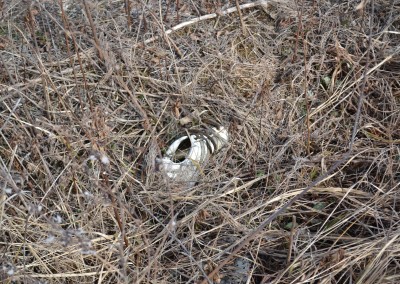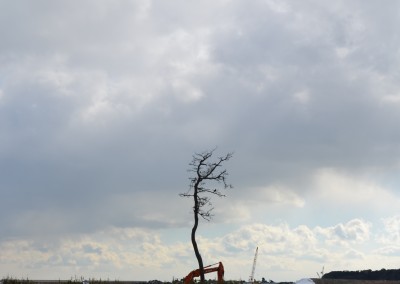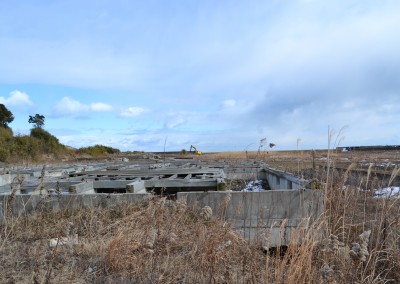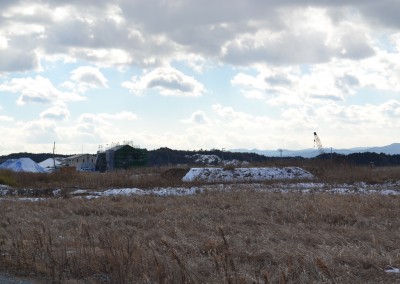Fukushima. One month ago, I used this word to refer to the partial and complete meltdown of the Fukushima Daiichi power plant resulting from the cataclysmic earthquake and tsunami on March 11, 2011. In most of my circles before coming to Japan, Fukushima represented a far-off tragedy and an example of the dangers of nuclear power. A week after visiting Fukushima Prefecture, the word stands for so much more. It stands for an entire prefecture’s agricultural profits damaged by the equating of “Fukushima” with radiation. It stands for roads clogged by families as they tried to flee the tsunami immediately after the earth stopped shaking. It stands for individuals from all over Japan who come to this area to work in the clean up efforts. It stands for fallow fields bountiful with black bags full of radioactive materials. It stands for empty houses and abandoned livestock. It stands for fields where neighborhoods once stood.
My experience last Monday was not my first with the aftermath of a natural disaster. New Orleans post-Katrina provided me with similar images of grasslands where houses once stood, as well as homes partially destroyed and abandoned. Neighborhoods of New Orleans were similar to the towns in Fukushima prefecture, yet they radically differed in the speed at which rebuilding occurs. The destruction caused by Hurricane Katrina was natural in origin. Humans had little ability to prevent or all together predict the damage or the path of the storm. The radiation contamination resulting from the meltdown of the Fukushima Daiichi power plant is in no way natural. Humans are the engineers of nuclear technology and thus the poisoning of the land is entirely human caused. As readings from Japan at Nature’s Edge highlight, there has been a long history of public protest of nuclear power facilities, however the Japanese government was determent to become self sufficient in producing power. The worries of rural communities were quieted with enormous promised sums pending the building of a nuclear power plant. With the promise of well paying jobs and community development, rural communities all across Japan consented to the building of nuclear technology sites close to residential areas. Residents of Fukushima Prefecture cannot go home because power companies and the national government built a powerfully dangerous piece of technology they did not have the power to control. Another stark contrast between my experience in New Orleans and in Minami-Soma was my role; in New Orleans, I volunteered for long hours but while I was in Fukushima Prefecture, I observed. I think I struggle with the discrepancies between the sites of the natural disasters so much because the presence of radiation, and the poisoning of the land prevented many including myself from taking an active helping role in the rebuilding process.
I tried to write this blog post the night we returned and then again the next night. Evidently, here I am, a week later, trying to put words to my experiences in a meaningful and useful way to myself and to my readers. Just like March 11, 2011 will remain in the collective psyche of Japan, January 25, 2016 will remain in mine as the day I bore witness to the devastation and to the suffering in the communities of Minami-Soma and the surrounding towns. Amid all of the despair, hurt, loss, and pain permeating the places we visited, there was hope. Hope and beauty and examples of human resilience. These lights of hope in an otherwise bleak place took the forms of a citizen lead radiation-testing center and in the continuation of a women’s group working to hold on to local customs and culture. These citizen movements helped to strengthen the local communities after the disaster caused many to flee.
Tuesday in class, all of us took some time to write in reflection to our experiences and then we each put a phrase on the board. All the words placed on the chalkboard put in writing both the reality of the destruction and the potential for hope. Below are several of the phrases from the board that have stuck with me for the past few days.
Was it worth it? Will we learn? We cannot forget.
MOTIVATION.
Should we question the government’s decisions or our own?
STRENGTH.
Hearing nothing but the wind, I heard our mistakes.
FAMILY.
We cannot separate politics and the environment.
ETHICS.
Fragility of modern society and its practices
HOPE.
Free radiation testing: information always comes with a cost.
I do not add the emphasis on the one-word lines above as I write this blog post. My classmates were the ones to single out and differentiate the words with positive meanings. This is a powerful example of the hope and resilience present in a land full of devastation. Even amidst all of the chaos created by the triple disaster, the people of the villages we visited were not broken. I see this clearly in the words chosen by my peers. These individuals of Fukushima are finding a way to rebuild and reinvest in the communities they still call home. From the free testing provided by the Minami-Soma Becquerel Center to the work of the FURE project and Professor Ishii, the people of Fukushima are the embodiment of hope and human tenacity.
The excursion to Fukushima left me teetering on the brink of despair for what I perceived to be ruined ecosystems and ruined communities. A lone gull flying over the landscape showed me that the Fukushima Daiichi disaster did not destroy nature for this bird still flew and let its call be heard. The many people I met who returned to Fukushima Prefecture showed me communities still intact. The women’s group who provided us lovely bento boxes for dinner provided a face for those impacted by the triple disaster but not crushed by it. The people of Fukushima have hope for the future; in their hope, I find mine.





Recent Comments